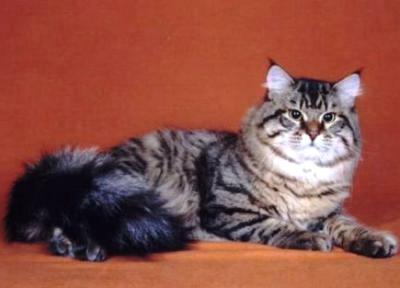 |
|
About the Breed

The Siberian cat is a medium to medium large, strong cat that hails from a very unforgiving
climate — Siberia. They first appeared in recorded history around the year 1000. According to folklore these
magnificent animals made their homes in Russian monasteries, where they would walk along the high beams as lookouts
for intruders. The overall appearance should be one of strength, and force with an excellent physical condition and
alertness, with a sweet facial expression.
The breed is extremely slow to mature taking as long as 5 years. The general impression is one of roundness and
circles, rather than rectangles and triangles. The Siberian has a very dog like temperament and they are very
affectionate. They are very intelligent, gentle and very quick learners.
The Siberian makes the ideal lap cat and will live quite happily indoors with you. Be the best company and friends
for you.
Standard of Siberian Cat
HEAD: the head is a modified wedge of medium size with rounded contours, broader at the
skull
and narrowin g slightly to a full and slightly rounded muzzle with a well-rounded chin. Female muzzles may be more
delicate than that of the males. The cheekbones are neither high set or prominent. There should be a good distance
between the ears and eyes. The top o f the head is flat, with a slight nose curvature of a gentle slope from the
forehead to the nose and a slight concave curvature before the tip. The neck is medium, rounded, substantial, and
well muscled. The whiskers are strong and long.
EARS: the ears are medium, wide at the base and set as much on the sides of the head as on
the
top; ideal position is 1 to 1-1/2 ear widths apart. The tips are rounded and the ear tilts forward. Lynx tipping is
desirable. Hair over the back of the ears is short and thin, from the middle of the ear, the furnishings become
longer and cover the base completely . The inner ear has an abundance of ear tufts. In juveniles and young kittens
only, the ears may appear to be medium-large and closer together with usually no more than one ear width apart.
EYES: large, round, wide set. If not held fully open the eye will appear to have the outer
corner slightly angled toward the lower base of the ear. In the traditional colors there is no relationship between
eye color and coat color/pattern. Eye color may cover the entire green, gold, hazel or copper spectrum. Blu e or
odd-eyed allowed in white cats. The typical adult color is green to green-gold. In the color point class the eyes
are blue.
BODY: substantial. The back is medium in length and very slightly curved or arched, the back
appears to be horizontal when in motion. The convex muscular torso and a round compact belly appear with age.
LEGS AND FEET: fur on the front legs thick, short to medium in length. Fur on hind legs
medium
to long, th ick and feather like. Legs are thick and dense and medium in length. The feet are big and round and toe
tufts are desirable.
TAIL: the tail is medium, somewhat shorter than the length of the body, wide at the base,
blunt
at the tip without thickening or kinks, evenly and thickly furnished.
COAT: this is a plush, medium length coat, with hair on the shoulder blades and lower part
of
the chest be ing thick and slightly shorter. There should be a ruff setting off the head, though allowances should
be made for juvenile cats. There is a tight undercoat, thicker in cold weather. Allow for warm climate coats. The
hair may thicken to curls on the bell y and britches, but a wavy coat is not characteristic. The skin may have a
bluish cast. Clear strong colors and patterns desirable, but are secondary to type. Coat texture may vary with the
color.
COLOR AND MARKINGS: All colors are genetically possible
A Hypo-Allergenic information of Siberian cats
|



